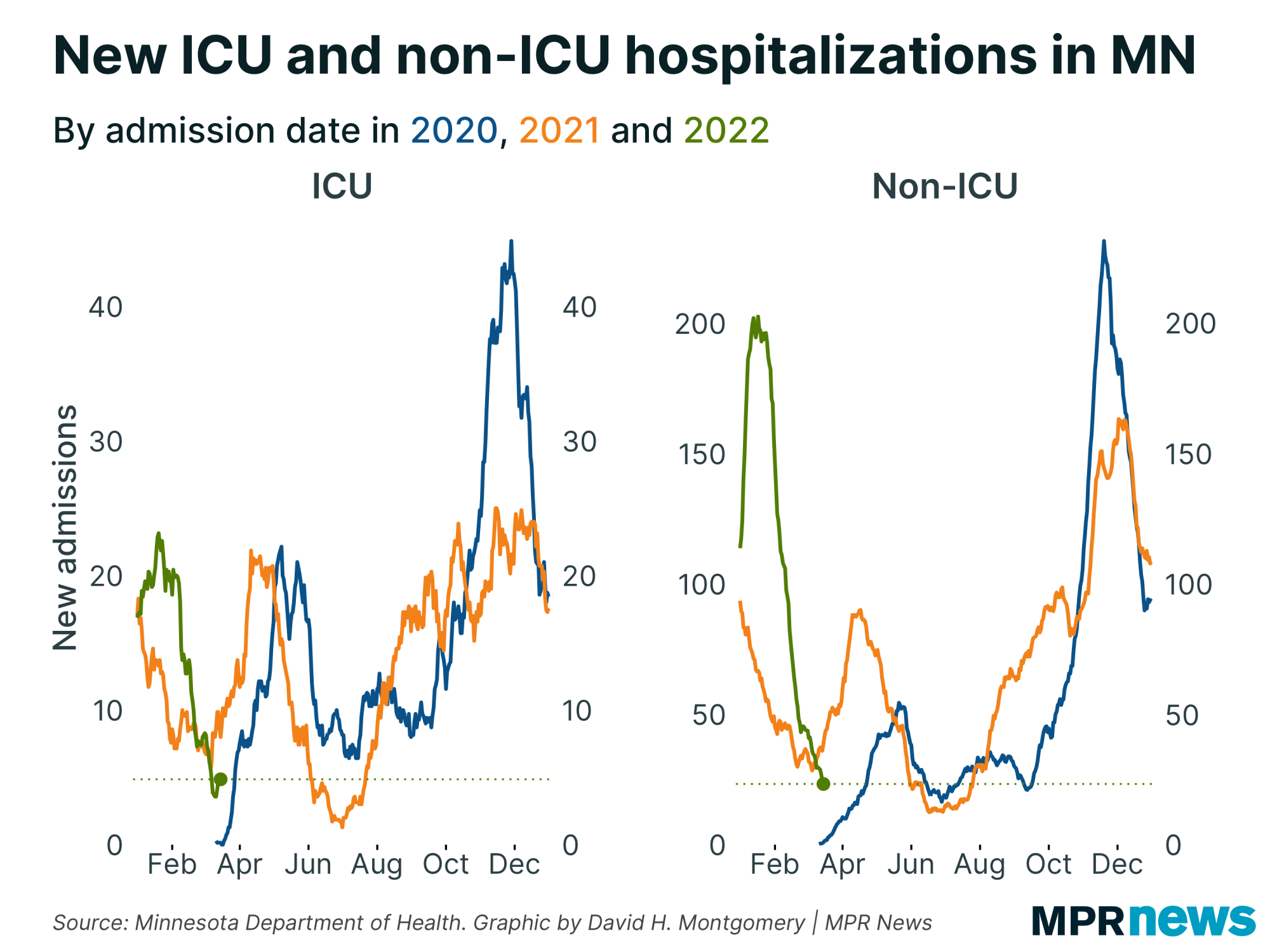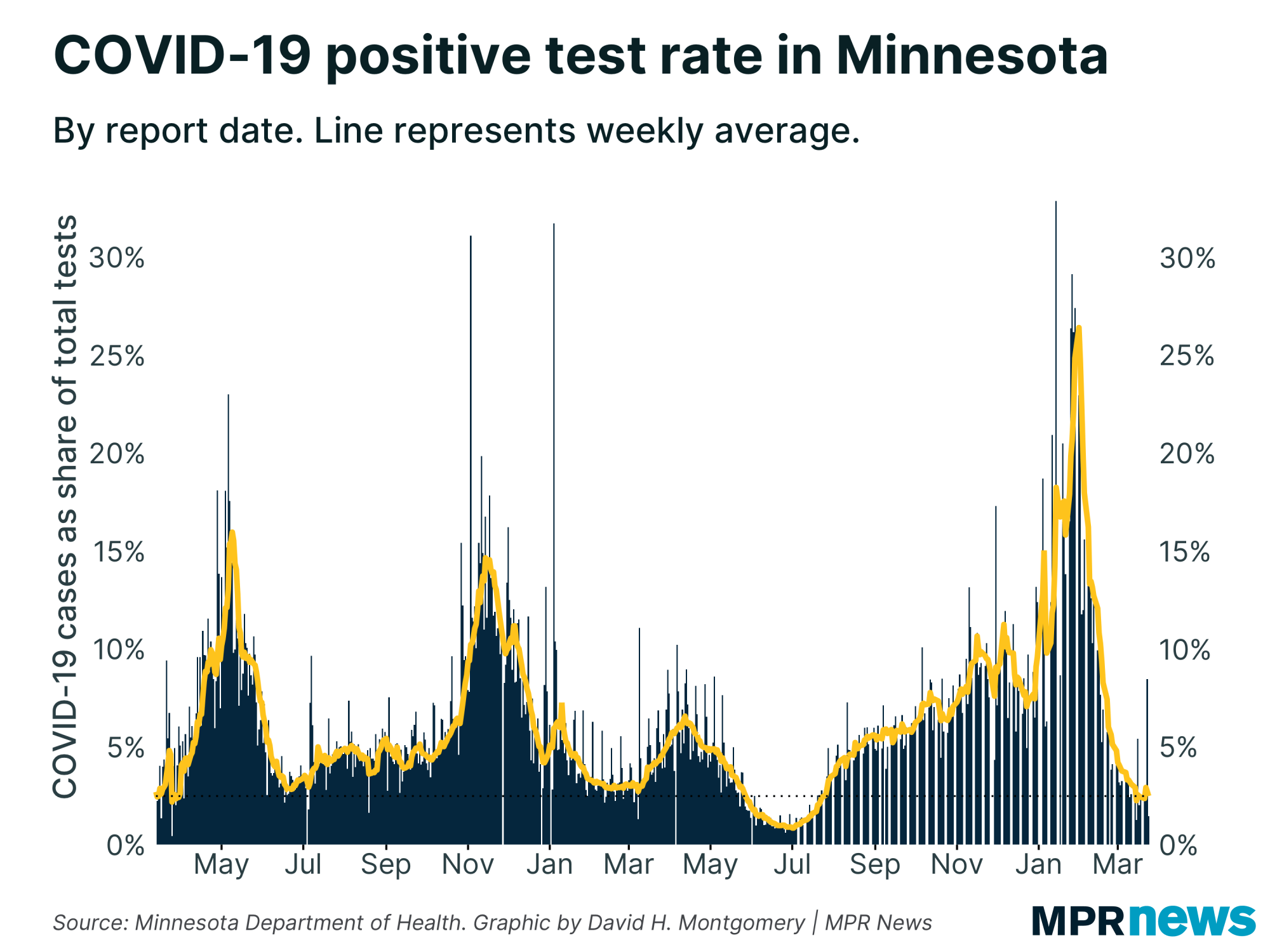Oct. 18 update on COVID-19 in MN: 11th straight day with 1,000+ cases

Go Deeper.
Create an account or log in to save stories.
Like this?
Thanks for liking this story! We have added it to a list of your favorite stories.
Minnesota reported 1,732 more confirmed COVID-19 cases on Sunday — the 11th consecutive day that the state has seen new case counts of more than 1,000.
State health officials also reported 17 more COVID-19 deaths, the fourth time in five days that the daily death toll has been in the double digits.
Sunday’s case count was a slight increase over Saturday’s report as testing also increased. The seven-day average test positivity rate ticked up slightly, to 5.7 percent — above the 5 percent figure that’s a key threshold in policy decisions by state leaders.
Cases have been increasing in all parts of the state in recent weeks.
Turn Up Your Support
MPR News helps you turn down the noise and build shared understanding. Turn up your support for this public resource and keep trusted journalism accessible to all.
"Things that we maybe did a month ago, when there was much, much less … community spread and number of cases, are riskier today," Health Commissioner Jan Malcolm told reporters on Friday. "And heading into the fall when we're going more indoors — it's just going to be all the more important that we really pay attention to those gathering limits and social distancing and masking."
The 17 deaths reported Sunday included 14 residents of long-term care facilities. New COVID-19 hospitalizations in Minnesota continue to trend upward to the highest levels seen since late May.
Here are Minnesota’s current COVID-19 statistics:
2,234 deaths (17 new)
122,812 positive cases (1,732 new), 108,316 off isolation
2,509,734 tests, 1,681,318 people tested
5.7 percent seven-day positive test rate
With COVID-19 case counts skyrocketing and deaths climbing, state public health leaders struck a decidedly somber tone this past week, pleading with Minnesotans to shoulder more personal responsibility to stem the spread of the disease.
Clearly frustrated by repeating the same advice for months, officials again implored people to wear masks in indoor public spaces, social distance and take other measures to stem the spread even when gathering with family and friends.

Officials ticked off a range of concerns about the current state of the pandemic, including uncontrolled spread in communities across Minnesota and the rising numbers of health care workers contracting the disease outside of their workplaces, workers that then become sidelined and temporarily unable to provide care for others.

Active, confirmed cases last week topped 10,000 and then rose again Sunday to more than 12,200 — another record in the pandemic.

‘Highs are getting higher’
Officials had anticipated seeing an October surge in cases expected from Labor Day weekend gatherings, sporting events, college student meetups and other informal affairs at the start of fall semester.
They also expected the wave would put more people in the hospital. That appears to be happening.

While the spike early in the pandemic was driven largely by illnesses tied to long-term care facilities and workplace sites such as meatpacking plants, officials say the current spread is diffused, making it even harder to trace and isolate cases.
Daily new case confirmation numbers have ebbed and flowed over the past seven months. However, “the lows are getting higher and the highs are getting higher,” Ehresmann told reporters last week, describing it as an “escalating roller coaster.”
The positive test rate trend remains above 5 percent, the threshold where officials become concerned.

State officials recently unveiled plans to massively expand COVID-19 testing opportunities across Minnesota as active caseloads remain at record highs and hospitalizations continue to climb.
Collectively, Minnesota will soon be able to process 60,000 tests per day, officials said, about twice what it’s managed on its best days until Friday, when the Health Department reported 44,500 tests completed.
“The biggest thing we can do to ensure our kids have an opportunity to be in school, that our businesses and restaurants remain open, is to simply follow the science around masking, around social distancing, getting tested,” Gov. Tim Walz told reporters Tuesday. “To not do these things will guarantee that others get it.”
Case counts rising across ages groups
New cases are up dramatically over the past month in all age groups. That includes a concerning rise in the number of new cases among Minnesotans ages 60 and older. It’s not clear what’s behind those increases.
People in their 20s still make up the age bracket with the state’s largest number of confirmed cases — more than 27,700 since the pandemic began, including more than 15,800 among people ages 20-24.

The numbers help explain why experts remain particularly concerned about young adults as spreaders of the virus.
While less likely to feel the worst effects of the disease and end up hospitalized, experts worry youth and young adults will spread it to grandparents and other vulnerable populations and that spread could hamper attempts to reopen campuses completely to in-person teaching.
The number of high school-age children confirmed with the disease has also grown, with more than 11,200 total cases among children ages 15 to 19 since the pandemic began.
Cases surging outside the Twin Cities metro area
Regionally, central, northern and southern Minnesota have driven much of the recent increase in new cases while Hennepin and Ramsey counties show some of the slowest case growth in the state.
Central Minnesota cases are leaping relative to its population. It’s not clear why. Northern Minnesota, once by far the region least affected by the disease, has also seen its caseload grow dramatically in recent weeks.
Collectively, rural areas of Minnesota continue to report the most new COVID-19 cases.

Early on, many Minnesotans thought COVID-19 would be only a Twin Cities metro area problem, but now the biggest problems are happening outside the suburban and urban parts of the state.
“The hottest of our hot spots are outside the metro area,” Ehresmann said last week.

Latino, Indigenous cases jump
In Minnesota and across the country, COVID-19 has hit communities of color disproportionately hard in both cases and deaths.
Minnesotans of Hispanic descent are testing positive for COVID-19 at about five times the rate of white Minnesotans. They, along with Black Minnesotans, are also being hospitalized and moved to intensive care units at higher rates than the overall population.
Similar trends hold true for Minnesota’s Indigenous and Asian residents. Counts among Indigenous people have jumped in the last week.

Friday’s numbers also show newly confirmed cases continuing to accelerate among Latino people in Minnesota.
Distrust of the government, together with deeply rooted health and economic disparities, have hampered efforts to boost testing among communities of color, particularly for unauthorized immigrants who fear their personal information may be used to deport them.
Developments around the state
Curbs eased for long-term care facility visits
Minnesota health officials on Monday put out new guidance to ease visiting rules for nursing homes and other long-term care facilities in the state.
Visitors must now be allowed if the long-term care facility has not had a COVID-19 exposure in the last 14 days. Another requirement for opening nursing homes is if there's low to medium virus transmission in the county.
There are exceptions if there is a reasonable or clinical safety cause not to open, such as staffing issues.
The new rules go into effect Saturday. They are being introduced to align with new federal recommendations. Visitors still must schedule their time with the facilities, be screened for symptoms and wear masks.
Long-term care settings have long been a deep concern for the state’s public health authorities. Among the 2,180 who’ve died from COVID-19 related complications in Minnesota, about 71 percent had been living in long-term care or assisted living facilities; nearly all had underlying health problems.
Officials had placed severe visiting restrictions early on in the pandemic, hoping to stem the spread of the disease. They’ve also acknowledged the psychological toll that takes on residents and their families.
— Peter Cox | MPR News
Officials tweak data reporting
The Health Department on Wednesday also unveiled new changes to the way it reports data on cases and deaths. Health authorities have begun reporting the results of antigen tests, a more rapid form of COVID-19 test, along with the results from the more traditional COVID-19 test known by its initials PCR.
The agency said it made the move so its reporting would align with federal guidance. Antigen testing had been relatively small prior to this, so the change to previous case counts won’t be dramatic.
The state, though, is now adding to the COVID-19 death toll people who died after having had COVID-19 confirmed by an antigen (rapid) test but not a PCR test. That added six people to the state’s death toll Wednesday on top of 23 newly reported deaths.
Even without the statistical tweak, it was still the highest number of daily deaths reported since mid-June. The jump follows similar spikes Wisconsin, which reported 34 deaths in its Tuesday report. North Dakota set a new record for daily deaths last week at 24.
— MPR News Staff
Top headlines
Minnesota jobless rate falls to 6 percent, but fewer seeking jobs: Minnesota's seasonally adjusted unemployment rate dropped sharply last month to 6 percent, down from 7.4 percent in August, but that decrease was due mostly to a significant dip in the number of people seeking work, state officials said.
Amid pandemic, Minnesota snowbirds wonder whether to stay put or go south: The pandemic is forcing some snowbirds to reevaluate their winter plans. One Minnesota couple is gearing up for their first winter in the state in 10 years.
National Guard tapped to fill staffing gap at Austin care facility: Staffing problems at Austin’s Sacred Heart Care Center started near the end of August, with the problem getting worse and worse over the course of several weeks until the facility needed help having enough care workers.
Judge blocks Wisconsin governor's indoor capacity limits amid spike in COVID-19 cases: The rules issued last week limited indoor public gatherings to no more than 25 percent of total occupancy limits. The state's Tavern League argued the caps would effectively put its members out of business.
COVID-19 in Minnesota
Data in these graphs are based on the Minnesota Department of Health's cumulative totals released at 11 a.m. daily. You can find more detailed statistics on COVID-19 at the Health Department website.


